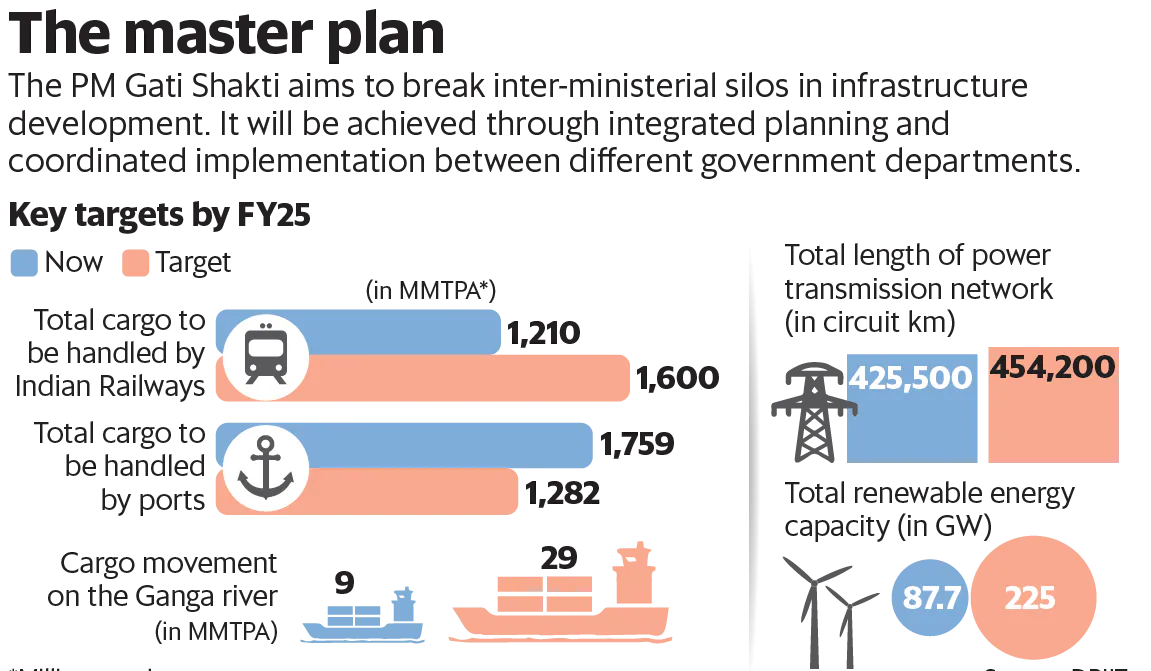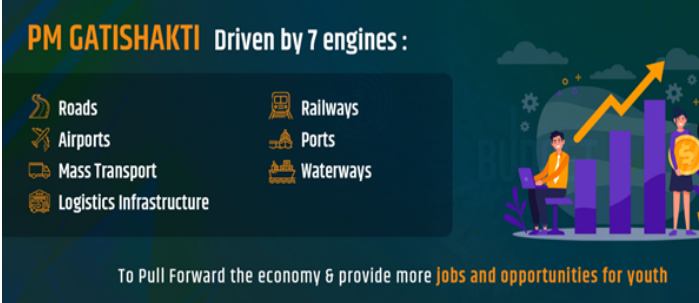Indian Economy
3 Years of PM GatiShakti National Master Plan
- 16 Oct 2024
- 12 min read
For Prelims: PM GatiShakti National Master Plan, Public-Private Partnerships (PPP), Parvatmala ropeways, Aspirational Blocks Programme.
For Mains: Issues with the Implementation of PM GatiShakti scheme, Challenges in the Indian Logistics Sector
Why in News?
Recently the Prime Minister praised the successful completion of 3 years of PM GatiShakti National Master Plan, calling it a transformative step in India’s infrastructure growth.
- The Prime Minister highlighted that GatiShakti is enhancing multimodal connectivity and boosting efficiency across sectors, benefiting logistics, job creation, and innovation.
What is PM GatiShakti National Master Plan?
- About:
- The PM Gati Shakti National Master Plan, launched in October 2021 is a transformative Rs. 100 lakh crore initiative aimed at revolutionising India’s infrastructure over the next five years.
- It has been developed as a Digital Master Planning tool by BISAG-N (Bhaskaracharya National Institute for Space Applications and Geoinformatics).
- It has been prepared in a dynamic Geographic Information System (GIS) platform wherein data on specific action plans of all the Ministries/Departments have been incorporated within a comprehensive database.
- The plan seeks to accelerate project completion, reduce timelines, and enhance India’s global competitiveness by breaking down inter-ministerial obstacles.
- The vision of PM GatiShakti is to create a world-class infrastructure that improves the ease of living, boosts economic growth and makes Indian businesses more competitive.

- Key Features:
- Digital Integration: It is a digital platform designed to integrate the efforts of 16 ministries, ensuring seamless infrastructure planning and execution across sectors.
- Multi-Sector Collaboration: The platform incorporates infrastructure initiatives from several major programs, including Bharatmala, Sagarmala, inland waterways, dry ports, and UDAN.
- Economic Zones: Focuses on developing key economic areas such as textile clusters, pharmaceutical hubs, defence corridors, and agricultural zones to boost economic productivity.
- Use of Technology: Advanced spatial planning tools and ISRO satellite imagery, developed by BiSAG-N, provide data-driven insights for project planning and management.
- Key Engines Driving PM GatiShakti:
- The National Master Plan revolves around seven primary sectors that drive economic growth and connectivity:

- These key engines are further supported by complementary sectors like energy transmission, IT communication, bulk water and sewerage, and social infrastructure.
- Together, these engines are designed to work in synergy, ensuring seamless logistics and connectivity across the nation.
- The National Master Plan revolves around seven primary sectors that drive economic growth and connectivity:
- The 6 Pillars of PM GatiShakti:
- Comprehensiveness: The plan integrates existing and planned initiatives across all ministries through a centralised portal, offering visibility into critical data and enabling efficient planning.
- Prioritisation: Ministries can prioritise projects more effectively by leveraging cross-sectoral interactions, ensuring that resources are allocated optimally based on national priorities.
- Optimisation: The plan identifies key gaps in infrastructure, helping to select the most efficient routes for transportation, reducing costs, and minimising delays.
- Synchronisation: Coordination across ministries ensures that projects are aligned and work in harmony, avoiding delays caused by silos and uncoordinated efforts.
- Analytical Capabilities: With over 200 data layers available on the GIS-based platform, PM GatiShakti provides comprehensive spatial planning tools for better decision-making and infrastructure visibility.
- Dynamic Monitoring: Real-time project monitoring through satellite imagery ensures that ministries can track progress and make necessary adjustments to keep projects on schedule.
What are the Achievements of PM GatiShakti National Master Plan?
- District-Level Expansion: PM GatiShakti has extended its platform to 27 aspirational districts, with plans to reach 750 districts in the coming months.
- Technological Integration: The use of geospatial tools and dynamic data layers has significantly improved real-time infrastructure planning and decision-making.
- Global Showcasing: The GatiShakti tool has been showcased to 30 countries in Central Asia and Southeast Asia, and was recently highlighted at the UNESCAP conference in Hong Kong and the Asia Pacific Business Forum.
- Social Sector Integration: Ministries such as the Ministry of Health and Family Welfare have identified internet-show areas and mapped sites for new healthcare facilities using NMP.
- Uttar Pradesh has utilised the platform to select sites for new hospitals and wheat purchase centres.
- Rural and Urban Impact: Districts like Dahod in Gujarat have used satellite imagery for planning low-cost drip irrigation systems, while Arunachal Pradesh has leveraged data visualisation to develop tourist potential around the Bichom Dam.
- In cities like Kanpur, Bengaluru, and Srinagar, city logistics plans have been developed to improve first- and last-mile connectivity.
- Employment and Vocational Training: The Ministry of Skill Development and Entrepreneurship is using the Gati Shakti approach to identify locations for setting up training institutes near industrial clusters and special economic zones.
What are the Challenges of PM GatiShakti National Master Plan?
- Data Integration and Accuracy: Combining real-time data from multiple ministries is difficult, and some of the data is outdated or incomplete, making planning less effective.
- For example, while land records are digitised in 13 states, the rest lag behind, slowing down project execution.
- Inter-Ministerial Coordination: Ministries often work in silos, causing delays and resource conflicts for major projects like roads and railways.
- A lack of proper coordination between states and ministries, as seen in the Sagarmala and Bharatmala projects, leads to slower progress
- Regulatory Bottlenecks: Projects face long delays in getting approvals, especially for environmental and land clearances.
- Even with tools for route optimization, power transmission projects in hilly areas take time to clear, slowing overall progress.
- Power and road projects in hilly areas often face delays due to environmental concerns, displacement issues, and local protests, slowing approval and progress.
- Financing and Resource Allocation: Securing enough funding for large projects, especially at the local level, is a challenge.
- Public-private partnerships (PPPs) are limited in many regions, leaving the government to bear the financial burden, which delays project completion.
- Lack of Skilled Manpower: Not all states have the necessary technology or skilled staff to fully use the GatiShakti platform, unlike states like Uttar Pradesh and Gujarat, which utilize it effectively.
- Project Monitoring and Accountability: Although the platform allows for real-time tracking, project updates are not always regular, which delays completion.
- For instance, rural road projects in many districts are not properly tracked, leading to slow progress.
How Can the Implementation of PM GatiShakti National Master Plan Be Enhanced?
- Improve Real-Time Data: Ministries should expand their use of satellite imagery and geospatial data to keep project data accurate and up-to-date.
- Accelerating land record digitization across all states will ensure smoother project implementation and reduce delays caused by outdated information.
- Enhance Inter-Ministerial Coordination: Create inter-ministerial task forces to improve communication and synchronisation between ministries.
- Use the GatiShakti platform to ensure all ministries can track each other’s activities in real-time, reducing delays and resource conflicts for large projects.
- Provide Training and Support for Technology Adoption: Expand Gati Shakti Vishwavidyalaya and set up regional centers to provide training in infrastructure planning and project management, ensuring states can fully use GatiShakti tools.
- Streamline Regulatory Approvals: Use GIS-based tools for faster environmental and land clearance processes.
- Fast-tracking approvals, especially for critical infrastructure projects, will help reduce the regulatory bottlenecks that slow down projects.
- Attract Private Investment: Use Infrastructure Investment Trusts (InvITs), Real Estate Investment Trusts (REITs) and Sovereign Wealth Funds to finance large-scale projects.
- This will help reduce the financial load on the government, improve resource allocation, and attract more private and international investors.
- Promote Sustainable Practices: Incorporate environmentally friendly practices into all infrastructure projects.
- Engage local communities early in the planning process to address environmental and social concerns, minimising resistance and ensuring smoother execution, especially in sensitive areas like the Himalayas.
|
Drishti Mains Question: What are the key challenges faced by the PM GatiShakti National Master Plan? |
UPSC Civil Services Examination, Previous Year Questions (PYQs)
Prelims
Q1. With reference to ‘National Investment and Infrastructure Fund’, which of the following statements is/are correct? (2017)
- It is an organ of NITI Aayog.
- It has a corpus of `4,00,000 crore at present.
Select the correct answer using the code given below:
(a) 1 only
(b) 2 only
(c) Both 1 and 2
(d) Neither 1 nor 2
Ans: (d)
Q2. In India, the term “Public Key Infrastructure” is used in the context of (2020)
(a) Digital security infrastructure
(b) Food security infrastructure
(c) Health care and education infrastructure
(d) Telecommunication and transportation infrastructure
Ans: (a)
Mains:
Q. “Investment in infrastructure is essential for more rapid and inclusive economic growth.” Discuss in the light of India’s experience. (2021)





